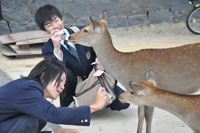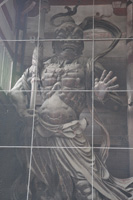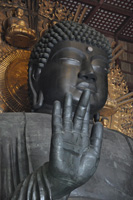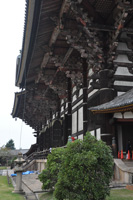 Nara is the capital city of Nara Prefecture in the Kansai region of Japan. The city occupies the northern part of Nara Prefecture, directly bordering Kyoto Prefecture. Eight temples, shrines and ruins in Nara, specifically Tōdai-ji, Saidai-ji, Kōfuku-ji, Kasuga Shrine, Gangō-ji, Yakushi-ji, Tōshōdai-ji and the Heijō Palace remains, together with Kasugayama Primeval Forest, collectively form "Historic Monuments of Ancient Nara", a UNESCO World Heritage Site.
Nara is the capital city of Nara Prefecture in the Kansai region of Japan. The city occupies the northern part of Nara Prefecture, directly bordering Kyoto Prefecture. Eight temples, shrines and ruins in Nara, specifically Tōdai-ji, Saidai-ji, Kōfuku-ji, Kasuga Shrine, Gangō-ji, Yakushi-ji, Tōshōdai-ji and the Heijō Palace remains, together with Kasugayama Primeval Forest, collectively form "Historic Monuments of Ancient Nara", a UNESCO World Heritage Site.
Nara was the capital of Japan from 710 to 784, lending its name to the Nara period. The original city, Heijō-kyō, was modelled after the capital of Tang Dynasty China, Chang'an (present-day Xi'an). According to the ancient Japanese book Nihon Shoki, the name "Nara" derived from the Japanese word narashita meaning "made flat". The temples of Nara remained powerful even beyond the move of the political capital to Heian-kyō in 794, thus giving Nara a synonym of Nanto (The Southern Capital). In 2010 Nara is celebrating its 1300th anniversary as the previous capital of Japan.
 Tōdai-ji temple complex with its Great Buddha Hall, the largest wooden building in the world, houses the world's largest bronze statue of the Buddha Vairocana, known in Japanese simply as Daibutsu. The temple also serves as the Japanese headquarters of the Kegon school of Buddhism. Sika deer, regarded as messengers of the gods in the Shinto religion, roam the grounds freely.
Tōdai-ji temple complex with its Great Buddha Hall, the largest wooden building in the world, houses the world's largest bronze statue of the Buddha Vairocana, known in Japanese simply as Daibutsu. The temple also serves as the Japanese headquarters of the Kegon school of Buddhism. Sika deer, regarded as messengers of the gods in the Shinto religion, roam the grounds freely.
The Great Buddha Hall has been rebuilt twice after fire. The current building was finished in 1709, and although immense—57 m long and 50 m wide—it is actually 30% smaller than its predecessor. The Great Buddha statue has been recast several times for various reasons, including earthquake damage. The current hands of the statue were made in the Momoyama Period (1568–1615), and the head was made in the Edo period (1615–1867).
 The existing Nandaimon (Great South Gate) is a reconstruction of end-12th century based on Song Dynasty style. The dancing figures of the Nio, the two 28-foot-tall guardians at the Nandaimon, were built at around the same time by Unkei, Kaikei and their workshop members. The Nio are known as Ungyo, which by tradition has a closed mouth, and Agyo, which has an open mouth. The two figures were closely evaluated and extensively restored by a team of art conservators between 1988 and 1993. Until then, these sculptures had never before been moved from the niches in which they were originally installed. This complex preservation project, costing $4.7 million, involved a restoration team of 15 experts from the National Treasure Repairing Institute in Kyoto.
The existing Nandaimon (Great South Gate) is a reconstruction of end-12th century based on Song Dynasty style. The dancing figures of the Nio, the two 28-foot-tall guardians at the Nandaimon, were built at around the same time by Unkei, Kaikei and their workshop members. The Nio are known as Ungyo, which by tradition has a closed mouth, and Agyo, which has an open mouth. The two figures were closely evaluated and extensively restored by a team of art conservators between 1988 and 1993. Until then, these sculptures had never before been moved from the niches in which they were originally installed. This complex preservation project, costing $4.7 million, involved a restoration team of 15 experts from the National Treasure Repairing Institute in Kyoto.
Along with Koya, Nara was one of the places I wanted to visit from when I began to plan the trip. In going to the political and spiritual origins of the country I would concurrently be attempting to get at my own social and spiritual foundations. While I go to significant lengths to plan a trip of this nature, I make no pretense of understanding the complexity of the Japanese people or the people I am fortunate enough to actually meet along the way. Any culture is viewed as interdynamically complex, but that much more so when it is not one's own. I can say something initial of what each of these moments means to me or what I take from them. Without prior reflection or with a desire to simply have a vacation I would likely say that these are magical moments, but under the circumstances that would be a totally superficial assessment.
The journey began at least a year ago when I noticed the impulse to go east. What's happening now is, in a certain sense, nothing new. Call them archetypes or universal expressions of a common humanity, I have been on the lookout for connecting principles for some time. Is it only obvious to me that liminality is expressed in these images? Roads, gates, thresholds, and vistas are dramatically evident in Japanese art and architecture. Nara was Field Trip Central. Do these kids know that they stand on their own respective and communal thresholds? Humanity is stuck, or is on the verge of something new. Could the same question be asked of the church, or at least my life in the church and ministry? It just now occurs to me that within the gates of temples and homes in Japan there is often a beam on the floor that has to be stepped over. It functions as a way to secure the gate, and it is a reminder that crossing the threshold is a deliberate act.











